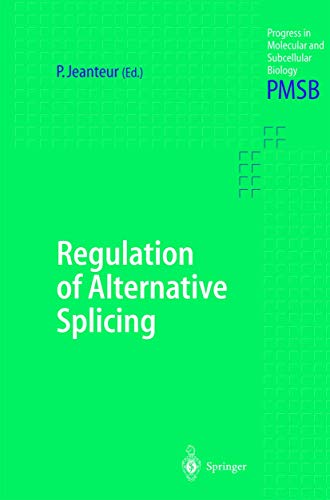Items related to Regulation of Alternative Splicing: 31 (Progress in...
Regulation of Alternative Splicing: 31 (Progress in Molecular and Subcellular Biology, 31) - Hardcover

"synopsis" may belong to another edition of this title.
"About this title" may belong to another edition of this title.
- PublisherSpringer
- Publication date2002
- ISBN 10 3540438335
- ISBN 13 9783540438335
- BindingHardcover
- Number of pages258
- EditorJeanteur Philippe
Buy New
Learn more about this copy
Shipping:
FREE
Within U.S.A.
Top Search Results from the AbeBooks Marketplace
Regulation of Alternative Splicing (Progress in Molecular and Subcellular Biology) [Hardcover ]
Print on DemandBook Description Hardcover. Condition: new. This item is printed on demand. Seller Inventory # 9783540438335
Regulation of Alternative Splicing
Book Description Condition: New. PRINT ON DEMAND Book; New; Fast Shipping from the UK. No. book. Seller Inventory # ria9783540438335_lsuk
Regulation of Alternative Splicing (Progress in Molecular and Subcellular Biology, 31)
Book Description Condition: New. Book is in NEW condition. Seller Inventory # 3540438335-2-1
Regulation of Alternative Splicing (Progress in Molecular and Subcellular Biology, 31)
Book Description Condition: New. New! This book is in the same immaculate condition as when it was published. Seller Inventory # 353-3540438335-new
Regulation of Alternative Splicing
Book Description Buch. Condition: Neu. This item is printed on demand - it takes 3-4 days longer - Neuware -The discovery in 1977 that genes are split into exons and introns has done away with the one gene - one protein dogma. Indeed, the removal of introns from the primary RNA transcript is not necessarily straightforward since there may be optional pathways leading to different messenger RNAs and consequently to different proteins. Examples of such an alternative splicing mechanism cover all fields of biology. Moreover, there are plenty of occurrences where deviant splicing can have pathological effects. Despite the high number of specific cases of alternative splicing, it was not until recently that the generality and extent of this phenomenon was fully appreciated. A superficial reading of the preliminary sequence of the human genome published in 2001 led to the surprising, and even deceiving to many scientists, low number of genes (around 32,000) which contrasted with the much higher figure around 150,000 which was previously envisioned. Attempts to make a global assessment of the use of alternative splicing are recent and rely essentially on the comparison of genomic mRNA and EST sequences as reviewed by Thanaraj and Stamm in the first chapter of this volume. Most recent estimates suggest that 40-60% of human genes might be alternatively spliced, as opposed to about 22% for C. elegans. 264 pp. Englisch. Seller Inventory # 9783540438335
Regulation of Alternative Splicing
Book Description Gebunden. Condition: New. Dieser Artikel ist ein Print on Demand Artikel und wird nach Ihrer Bestellung fuer Sie gedruckt. Excellent overview of alternative splicingIncorporates newly emerging technologies and research directionsThe discovery in 1977 that genes are split into exons and introns has done away with the one gene - one protein dogma. Indeed, the removal of i. Seller Inventory # 4890683
Regulation of Alternative Splicing
Book Description Buch. Condition: Neu. Druck auf Anfrage Neuware - Printed after ordering - The discovery in 1977 that genes are split into exons and introns has done away with the one gene - one protein dogma. Indeed, the removal of introns from the primary RNA transcript is not necessarily straightforward since there may be optional pathways leading to different messenger RNAs and consequently to different proteins. Examples of such an alternative splicing mechanism cover all fields of biology. Moreover, there are plenty of occurrences where deviant splicing can have pathological effects. Despite the high number of specific cases of alternative splicing, it was not until recently that the generality and extent of this phenomenon was fully appreciated. A superficial reading of the preliminary sequence of the human genome published in 2001 led to the surprising, and even deceiving to many scientists, low number of genes (around 32,000) which contrasted with the much higher figure around 150,000 which was previously envisioned. Attempts to make a global assessment of the use of alternative splicing are recent and rely essentially on the comparison of genomic mRNA and EST sequences as reviewed by Thanaraj and Stamm in the first chapter of this volume. Most recent estimates suggest that 40-60% of human genes might be alternatively spliced, as opposed to about 22% for C. elegans. Seller Inventory # 9783540438335
Regulation of Alternative Splicing
Book Description Hardcover. Condition: Brand New. 1st edition. 245 pages. 10.25x6.25x0.50 inches. In Stock. Seller Inventory # x-3540438335

